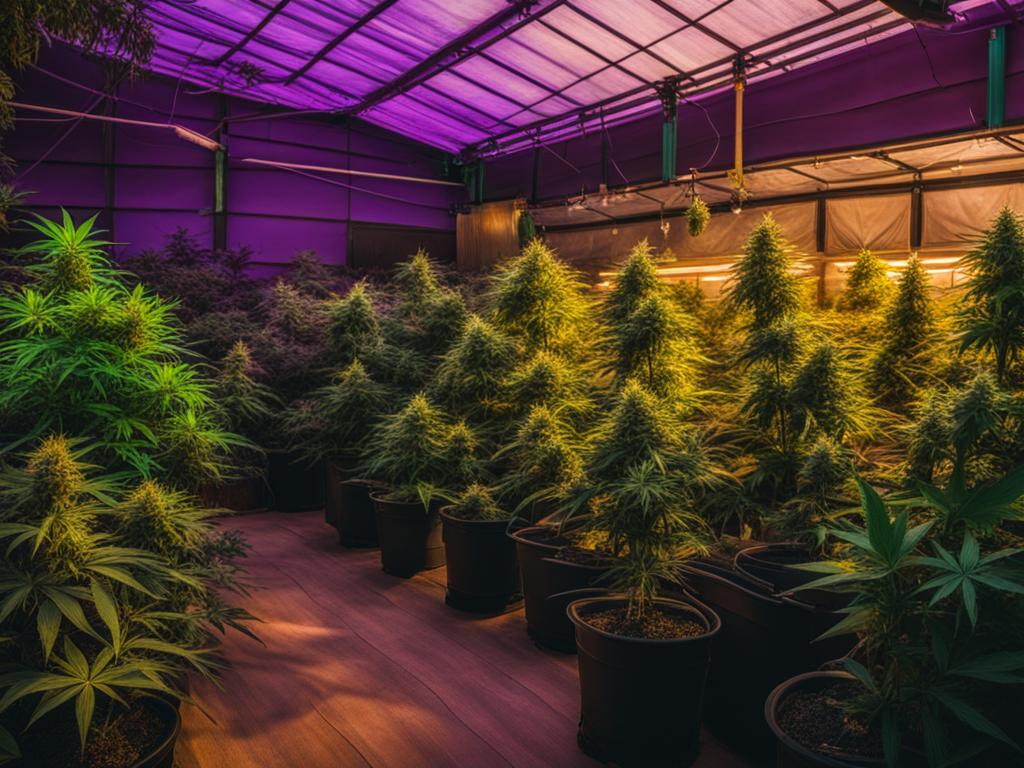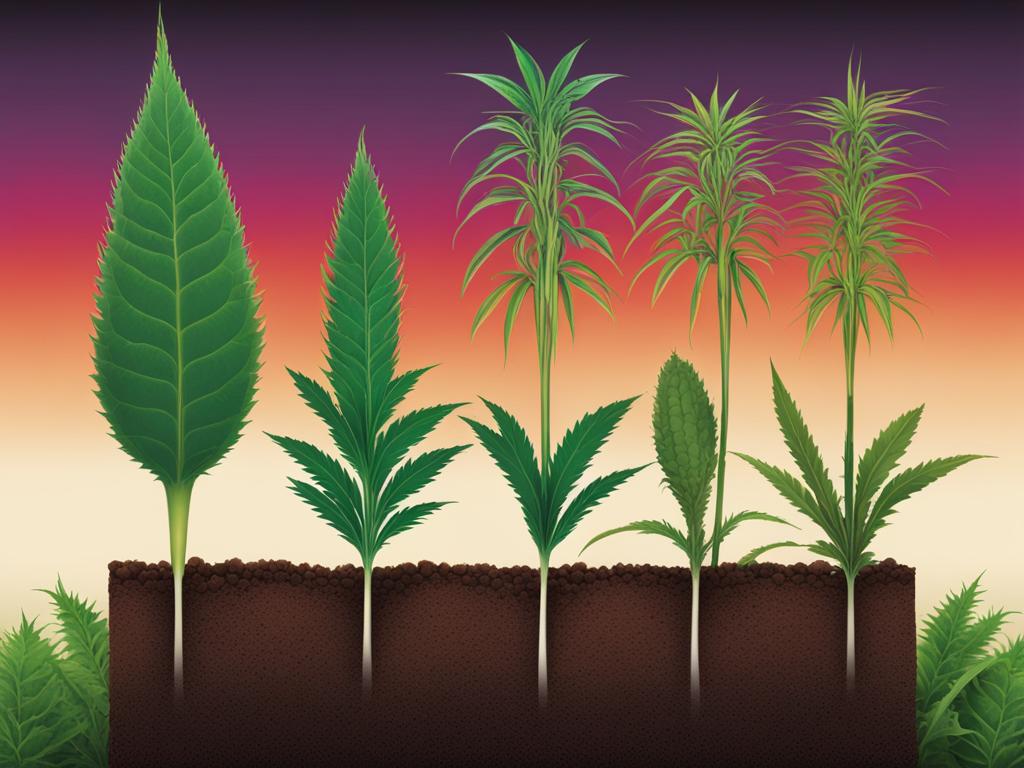Growing marijuana can be subject to special restrictions and regulations. Consult with your attorney before cultivating cannabis. In this guide, we will explore the key differences in growing Indica and Sativa strains to help you achieve success.
Key Takeaways:
- Understanding the characteristics of Indica and Sativa plants is crucial for successful cultivation.
- Indica plants are shorter and wider, while Sativa plants are taller and thinner.
- Indica strains have a shorter flowering time and higher yields, making them suitable for short growing seasons or limited spaces.
- Sativa strains have a longer flowering time and lower yields, thriving in hot and humid environments.
- Hybrid strains combine the best traits of Indica and Sativa, offering a variety of flowering times and yields.
Now that we have covered the basics, let’s delve into the characteristics and cultivation techniques for Indica and Sativa strains.
Characteristics of Indica and Sativa Plants
When it comes to cultivating marijuana, understanding the characteristics of different strains is essential for success. In this section, we will explore the distinguishing features of Indica and Sativa plants, as well as the differences in cultivation techniques required for each.
Indica plants are known for their shorter stature, wider leaves, and dark green coloration. They typically have a bushy appearance and thrive in indoor environments. On the other hand, Sativa plants are taller, with thinner leaves and a lighter shade of green. They are better suited for outdoor cultivation due to their ability to tolerate higher temperatures and humidity levels.
The chemical composition of Indica and Sativa strains also differs, resulting in variations in the effects they produce. Indica strains contain compounds like camphene, myrcene, and linalool, which contribute to their relaxing and sedating properties. Sativa strains, on the other hand, contain compounds like caryophyllene, limonene, and pinene, which are associated with uplifting and energizing effects.
These physical and chemical differences between Indica and Sativa plants play a significant role in determining the cultivation techniques required for each. In the next sections, we will delve deeper into the specifics of cultivating Indica and Sativa strains, both indoors and outdoors.
Table: Characteristics of Indica and Sativa Plants
| Characteristics | Indica Plants | Sativa Plants |
|---|---|---|
| Plant Height | Shorter | Taller |
| Leaf Shape | Wider | Thinner |
| Leaf Color | Dark Green | Light Green |
| Chemical Composition | Compounds like camphene, myrcene, and linalool | Compounds like caryophyllene, limonene, and pinene |
Best Practices for Cultivating Indica Strains
Growing Indica strains can be an exciting and rewarding experience for marijuana cultivators. These strains are known for their shorter flowering time and higher yields, making them ideal for both outdoor and indoor cultivation. To maximize the yield with Indica and ensure successful growth, we have compiled a list of best practices.
I. Hydroponic Systems
When cultivating Indica strains, using hydroponic systems can significantly enhance the growth and yield of your plants. Hydroponics allows for precise control over the nutrients, water, and oxygen levels that the plants receive, resulting in faster growth and larger buds. Consider implementing a hydroponic setup, such as a deep water culture (DWC) or nutrient film technique (NFT), to optimize the cultivation of your Indica strains.
II. Organic Fertilizers
Indica strains respond well to organic fertilizers, such as HESI fertilizers. These fertilizers provide essential nutrients to the plants while promoting healthy root development and overall growth. Organic fertilizers are free from synthetic chemicals, making them a safe and eco-friendly choice for cultivators. Incorporate organic fertilizers into your feeding schedule to nourish your Indica plants and maximize their yield.
III. Choosing Indica Dominant Strains
When selecting Indica strains for cultivation, opting for Indica-dominant hybrids can be beneficial. These strains inherit the desirable characteristics of Indica plants, such as compact size and high resin production, while also offering unique flavor profiles and effects. Popular Indica dominant strains to consider growing include Northern Lights, Blue Cheese, Papaya, and Granddaddy Purple. Research and choose strains that align with your preferences and cultivation goals.
By implementing these best practices, you can cultivate Indica strains successfully and maximize their yield. Remember to provide optimal growing conditions, monitor the plants closely, and adjust the cultivation techniques as needed. Happy growing!
| Best Practices for Cultivating Indica Strains | Description |
|---|---|
| Hydroponic Systems | Implement a hydroponic setup to enhance growth and yield |
| Organic Fertilizers | Use organic fertilizers like HESI fertilizers for nourishment |
| Choosing Indica Dominant Strains | Select Indica-dominant hybrids for desired characteristics |

Table: Best practices for cultivating Indica strains. Implementing hydroponic systems, using organic fertilizers, and selecting Indica-dominant strains can greatly enhance the growth and yield of your Indica plants.
Optimal Techniques for Sativa Cultivation
When it comes to cultivating Sativa dominant strains, optimizing your techniques is the key to success. Sativa plants have specific needs and require careful attention to ensure they reach their full potential.
To start with, providing proper lighting is crucial for Sativa cultivation. These plants thrive under intense light conditions, so using high-quality grow lights with the right spectrum and intensity is essential. Consider using LED or HID lights to mimic the intensity of natural sunlight for optimal growth.
In addition to lighting, faster vegetative growth is essential for Sativa plants. They have a longer flowering time compared to Indica strains, so promoting vigorous vegetative growth is crucial. This can be achieved by using nutrient-rich soil, providing adequate nutrition with organic fertilizers, and maintaining optimal temperature and humidity levels in your growing environment.
Lastly, selecting Sativa strains with faster flowering times and increased yields can significantly enhance your cultivation results. Some popular Sativa strains that are known for their exceptional characteristics include Strawberry Cough, Durban Poison, Sour Diesel, and Amnesia Haze. These strains offer a unique combination of uplifting effects and delicious flavors.
Comparison of Sativa and Indica Cultivation Techniques
| Sativa | Indica | |
|---|---|---|
| Lighting | Requires intense light conditions | Can tolerate lower light intensity |
| Vegetative Growth | Needs faster vegetative growth for longer flowering time | Requires less vegetative growth due to shorter flowering time |
| Flowering Time | Longer flowering time compared to Indica strains | Shorter flowering time compared to Sativa strains |
| Yield | Lower yields compared to Indica strains | Higher yields compared to Sativa strains |
| Popular Strains | Strawberry Cough, Durban Poison, Sour Diesel, Amnesia Haze | Northern Lights, Blue Cheese, Papaya, Granddaddy Purple |
Growing Hybrids – The Best of Both Worlds
Hybrid cannabis plants offer cultivators the unique opportunity to combine the desirable traits of both Indica and Sativa strains. By crossbreeding different strains, growers can create hybrids that provide a wide range of flowering times, yields, and effects. Whether you’re a beginner or an experienced cultivator, growing hybrid plants can be an exciting and rewarding endeavor.
When it comes to growing hybrids, it’s important to understand that each hybrid strain is unique and may require specific cultivation techniques. Some hybrids lean more towards the Indica side, while others lean towards Sativa. This means that their characteristics and growing requirements can vary widely.
To successfully grow hybrids, it’s crucial to research the specific strain you’re interested in cultivating. Consult with experienced growers or seed breeders who can provide valuable insights and guidance. They can recommend the best cultivation practices for the particular hybrid strain you’ve chosen, including optimal lighting, feeding schedules, and environmental conditions.

Benefits of Growing Hybrid Cannabis Plants
One of the main advantages of growing hybrid cannabis plants is the ability to tailor the effects and characteristics of the final product. Indica-dominant hybrids tend to offer relaxing, body-focused effects, making them suitable for nighttime use or managing pain and insomnia. Sativa-dominant hybrids, on the other hand, are known for their uplifting and energizing effects, making them ideal for daytime use or boosting creativity and focus.
Hybrids also allow growers to experiment with different flavors, aromas, and potency levels. By combining the terpene profiles and cannabinoid ratios of different strains, cultivators can create unique and customized experiences for consumers. This diversity of options makes hybrid cultivation a popular choice among both recreational and medical cannabis users.
Cultivating Hybrids: A Flexible Approach
When cultivating hybrid strains, it’s essential to remain flexible in your approach. Hybrids can exhibit a wide range of growth patterns, flowering times, and nutrient requirements. Keep a close eye on your plants and adjust your cultivation techniques accordingly. Monitor their response to different environmental conditions, feeding schedules, and training methods, and make adjustments as needed.
Remember, cultivating hybrid strains is an art that requires patience, attention to detail, and a willingness to adapt. Embrace the journey of discovering the unique characteristics and effects of each hybrid strain you grow. With proper research, guidance, and hands-on experience, you’ll be on your way to cultivating the best of both Indica and Sativa worlds.
Similarities in Growing Indica, Sativa, and Hybrid Strains
When it comes to cultivating cannabis, there are distinct differences between Indica, Sativa, and hybrid strains. However, there are also several similarities in the best cultivation practices for all three types. Whether you’re growing Indica, Sativa, or hybrid strains, attention to detail and proper care are essential for successful cultivation.
One important aspect of cultivation is maintaining a consistent watering schedule. All cannabis strains require adequate hydration, but it’s crucial to find the right balance. Overwatering can lead to root rot and other issues, while underwatering can stunt growth and reduce yield. Monitoring the soil moisture levels and adjusting watering accordingly is key.
Another important practice is trimming and training the plants if necessary. This helps promote better airflow and light penetration, which can improve overall plant health and yield. Removing any yellowing or damaged leaves can also prevent the spread of pests and diseases. Additionally, adjusting the amount of light over time is crucial for all strains, as different stages of growth require varying levels of light intensity and duration.
Regardless of the strain, using high-quality cannabis soil is essential for optimal growth and yield. SoHum Living Soils® is a great option that provides a balanced blend of nutrients and beneficial microbes to support healthy plant development. The living soil approach mimics natural ecosystems and helps create an environment where cannabis plants can thrive. Remember to follow the manufacturer’s instructions for best results.
“Proper care and attention to detail are crucial for successful cannabis cultivation. Whether you’re growing Indica, Sativa, or hybrid strains, maintaining a consistent watering schedule, trimming and training plants, and using high-quality soil are key practices. By implementing these best cultivation practices, you’ll be well on your way to a successful harvest.” – Cannabis Cultivation Expert
Overall, while there are differences in growing Indica, Sativa, and hybrid strains, the best cultivation practices share many similarities. By paying close attention to the unique needs of each strain and implementing these practices, you can maximize growth and yield. Whether you’re a beginner or an experienced grower, following these guidelines will help you achieve successful cannabis cultivation.
| Best Cultivation Practices | |
|---|---|
| Watering | Maintain a consistent watering schedule, adjusting for soil moisture levels. |
| Trimming and Training | Promote airflow and light penetration by trimming and training plants as needed. |
| Lighting | Adjust the amount of light over time to meet the specific needs of each strain. |
| Soil | Use high-quality cannabis soil, like SoHum Living Soils®, for optimal growth and yield. |
Conclusion
Growing Indica and Sativa strains requires different cultivation techniques, but with the right approach, you can achieve success. Understanding the unique characteristics of each strain and implementing the appropriate growing practices is essential.
When cultivating Indica strains, focus on maximizing yield by using hydro systems and organic fertilizers, like HESI fertilizers. Consider popular Indica strains such as Northern Lights, Blue Cheese, Papaya, and Granddaddy Purple.
For Sativa cultivation, optimize your techniques by providing proper lighting, ensuring faster vegetative growth, and choosing strains with faster flowering times and increased yields. Some popular Sativa strains to try growing are Strawberry Cough, Durban Poison, Sour Diesel, and Amnesia Haze.
Remember, whether you choose Indica, Sativa, or hybrid strains, research and consultation with experienced growers are key. By implementing the right cultivation tips and techniques, you’ll be well on your way to a successful harvest. Happy growing!
FAQ
Are there any special restrictions or regulations for growing marijuana?
Yes, growing marijuana can be subject to special restrictions and regulations. It is important to consult with your attorney before cultivating cannabis to ensure compliance with local laws.
What are the key differences between Indica and Sativa plants?
Indica plants are typically shorter, wider, and have dark green leaves, while Sativa plants are taller, thinner, and have light green leaves. They also have different chemical compositions, with Indica containing compounds like camphene, myrcene, and linalool, and Sativa containing compounds like caryophyllene, limonene, and pinene.
Which strains are ideal for short outdoor growing seasons or limited indoor space?
Indica strains are best suited for short outdoor growing seasons or indoor gardens with limited space. Some popular Indica strains to consider growing are Northern Lights, Blue Cheese, Papaya, and Granddaddy Purple.
How can I increase yields when growing Indica strains?
Best practices for cultivating Indica strains include using hydro systems and organic fertilizers, such as HESI fertilizers, to maximize yields.
What are the best techniques for Sativa cultivation?
Optimal techniques for Sativa cultivation include providing proper lighting, encouraging faster vegetative growth, and using strains with faster flowering times and increased yields. Some popular Sativa strains to try growing are Strawberry Cough, Durban Poison, Sour Diesel, and Amnesia Haze.
What are hybrid cannabis plants and how do they differ in cultivation?
Hybrid cannabis plants combine the characteristics of both Indica and Sativa strains. They offer a variety of flowering times and yields depending on their genetic makeup. The specific growing requirements for hybrids can vary, so it is important to research the specific strain and consult with experienced growers.
What are the essential practices for growing Indica, Sativa, and hybrid strains?
Attention to detail, a well-planned watering schedule, proper trimming and training if necessary, and adjusting the amount of light over time are essential for all strains. Using high-quality cannabis soil, like SoHum Living Soils®, can also help maximize growth and yield.
Is there a conclusion to this guide?
This guide provides an overview of the key differences in growing Indica and Sativa strains. It emphasizes the importance of understanding the characteristics of each strain and implementing the appropriate cultivation techniques. Remember to research and consult with experienced growers to optimize your cultivation process. Happy growing!
Source Links
- https://myplantin.com/weed/sativa-vs-indica-growing
- https://sohumsoils.com/differences-growing-sativa-indica-hybrid/
- https://www.leafly.com/news/growing/differences-growing-sativa-indica-hybrid-strains
Author Profile

Latest entries
 BlogFebruary 20, 2024I Just Found the Ultimate Clog-Free Vape Cartridge! (Yes, They Exist!)
BlogFebruary 20, 2024I Just Found the Ultimate Clog-Free Vape Cartridge! (Yes, They Exist!) BlogJanuary 16, 2024In the Clouds with Creativity: A Blunt Encounter with Montreal’s Fluid Art Maestro
BlogJanuary 16, 2024In the Clouds with Creativity: A Blunt Encounter with Montreal’s Fluid Art Maestro BlogDecember 25, 2023Sativa: Enhancing Outdoor Adventures
BlogDecember 25, 2023Sativa: Enhancing Outdoor Adventures BlogDecember 25, 2023Enhancing Memory with Sativa
BlogDecember 25, 2023Enhancing Memory with Sativa





